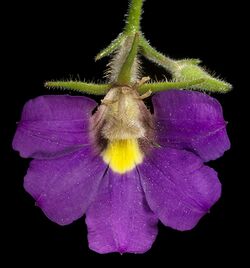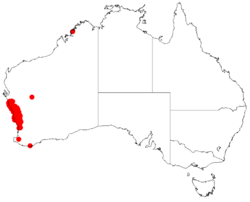Biology:Scaevola phlebopetala
| Scaevola phlebopetala | |
|---|---|

| |
| Scientific classification | |
| Kingdom: | Plantae |
| Clade: | Tracheophytes |
| Clade: | Angiosperms |
| Clade: | Eudicots |
| Clade: | Asterids |
| Order: | Asterales |
| Family: | Goodeniaceae |
| Genus: | Scaevola |
| Species: | S. phlebopetala
|
| Binomial name | |
| Scaevola phlebopetala | |

| |
| Occurrence data from Australasian Virtual Herbarium | |
| Synonyms[1] | |
|
Lobelia phlebopetala (F.Muell.) Kuntze | |
Scaevola phlebopetala, commonly known as velvet fanflower, is a herb in the family Goodeniaceae and is endemic to Western Australia.[3]
Description
Scaevola phlebopetala is a generally prostrate herb, with stems growing to 50 cm.[4] The stems are bristly, with hairs at 90° and sometimes rough to the touch.[4] The leaves are stalkless and usually toothed with the leaf blade being from 1.2 to 10 cm long by 3 to 17 mm wide.[4] The flowers occur in racemes which are up to 30 cm long.[4] The inflorescence stalk is 2–4.5 cm long and curved. The sepals are linear, 4–14 mm long, and not joined.[4] The corolla is from 10–27 mm long, and has both short, white hairs and long, stiff, yellow hairs on the outside, and is densely bearded on the inside.[4] It is deep purple and yellow in the throat. The fruit is obovoid, striated, warty, hairy and 5–6 mm long.[4] It flowers from June to October.[4]
Distribution and habitat
It is found in southwest Western Australia growing in sandy heaths.[4]
Taxonomy
It was first named and described by Ferdinand von Mueller in 1860.[1][2] The specific epithet, phlebopetala, derives from the Greek, phlebos ("vein")[5] and the Latin, petalum ("petal") to give an adjective describing the plant as having "veined petals".[6]
References
- ↑ 1.0 1.1 1.2 "Scaevola phlebopetala". Australian Plant Name Index (APNI), IBIS database. Centre for Plant Biodiversity Research, Australian Government. https://biodiversity.org.au/nsl/services/rest/name/apni/111288.
- ↑ 2.0 2.1 Mueller, F.J.H. von (1860). "Scaevola phlebopetala". Fragmenta Phytographiae Australiae 2 (11): 18. https://www.biodiversitylibrary.org/page/760803. Retrieved 2020-03-26.
- ↑ "Scaevola phlebopetalae". FloraBase. Western Australian Government Department of Parks and Wildlife. https://florabase.dpaw.wa.gov.au/browse/profile/7634.
- ↑ 4.0 4.1 4.2 4.3 4.4 4.5 4.6 4.7 4.8 R.C.Carolin, R.C. (2020). "Scaevola phlebopetala". Flora of Australia. Australian Biological Resources Study, Department of Agriculture, Water and the Environment, Canberra. https://profiles.ala.org.au/opus/foa/profile/Scaevola%20phlebopetala. Retrieved 2020-03-26.
- ↑ Backer, C.A. (1936). Verklarend woordenboek der wetenschappelijke namen van de in Nederland en Nederlandsch-Indië in het wild groeiende en in tuinen en parken gekweekte varens en hoogere planten (Edition Nicoline van der Sijs). p. 441. https://www.dbnl.org/tekst/back062verk02_01/back062verk02_01_0001.php.
- ↑ Stearn, W.T. (2004). Botanical Latin (4 ed.). Timber Press, Oregon. p. 465. ISBN 9780715316436.
Wikidata ☰ Q17480613 entry
.
 |

